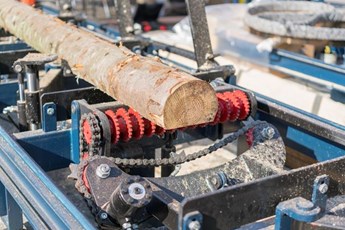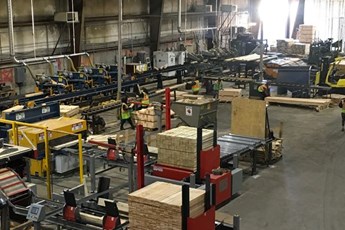Mold-Season-is-Coming-Prepare-to-Protect
When it comes to airborne mold spores, what we can’t see definitely can hurt us. Unfortunately, when the weather gets warm in spring and conditions are right, those spores can quickly colonize surfaces. In days, mold can spread from idle lumber or a pallet to contaminate materials and equipment. As a result, employee health and safety, as well as sensitive products, can be compromised.
What is lumber mold and why does it matter?
A mold is a fungus that grows in the form of multicellular filaments called hyphae. There are more than 100,000 mold species, which play an important role in helping to decompose wood and other plant matter. They become problematic, however, when they take root on lumber, pallets, and other unintended surfaces.
To successfully colonize a surface, mold requires a combination of oxygen, adequate temperature, a food source (your wood pallets), and free or liquid water. The most common approach to controlling mold is to limit wood moisture. Experts recommend that the moisture content of wood be kept below 19% for best results.
One common misconception is that the ISPM 15 heat treatment of lumber will prevent mold. The application of heat treatment is (a minimum of 30 minutes at a core temperature of 56 degrees Celsius) is designed to kill insects living in the treated wood. The intention is to prevent the inadvertent transport of wood pests internationally, where they could attack forests in other countries. In fact, heat treatment can make matters worse by drawing moisture and sugars to the wood surface. Once removed from the heat chamber, a convenient surface environment has been created for mold spores to colonize.
Product manufacturers, distributors, and retailers in hygiene-sensitive supply chains are becoming increasingly sensitive to the problem of mold. The presence of mold not only presents a food safety and quality risk but is also a concern from an occupational health and safety standpoint. Pharmaceutical and food supply chains are particularly vigilant in preventing exposure, and the presence of mold has resulted in health and safety complaints by employees in a variety of settings.
Basic steps to limit lumber mold
Basic steps for limiting lumber mold start with keeping them dry. Here are some best recommended best practices:
Make sure that mold is actually the issue. The discoloration you see in your wood pallets might not be mold. Bluestain creates a bluish or greyish discoloration in wood but is not associated with human health concerns or pallet performance issues. According to an NWPCA brochure, “Mold grows on the surface and can be brushed off or smeared, whereas blue stain penetrates deep into the wood and cannot be removed.”
- Keep lumber out of the rain. Even a short exposure to water can be problematic. Such a brief occurrence can be enough for a fungus to start germinating, grow into the wood and produce spores on the surface. By then the wood might be dry, but mold will already be present.
- Elevate stacked pallets and lumber off the ground. By using an elevated surface, you can prevent water from wicking up from any puddles on the floor surface or ground.
- Don’t store lumber in a trailer. Dark, warm, and humid trailers can quickly turn into an incubator for mold growth. Coordinate deliveries with trading partners so that lumber can be quickly unloaded and placed into dry storage.
- Keep lumber in a well-lit, dry, and ventilated environment. Covered storage is critical for keeping lumber dry. For outdoor storage sheds, pallet ends of stringer pallets should be aligned in the direction of the prevailing winds to help improve airflow. For indoor storage, choose a well-lit, ventilated part of the warehouse.
- Ensure row spacing to further promote ventilation. Stacked stringer pallets can act as a barrier to air movement on the stringer side. Circulation can be improved by leaving a gap between pallet rows. Orient the ends of stringer pallets in the direction of air movement.
- Consider KD softwood lumber and pallets. More industries are switching to kiln-dried softwood pallets. While some applications still require the use of hardwood, KD softwood pallets can be designed to deliver comparable service, without the mold challenges associated with pallet heat treatment.
What about traditional chemical treatment options?
In spite of heroic efforts to keep pallets dry in warm weather, pallets far too frequently have exposure to the necessary combination of heat and moisture, and mold results. Even if you keep your pallets under 19% moisture content, small localized wet spots can provide the needed ingredients for mold to colonize.
To improve protection against mold, lumber and pallet providers have relied on hazardous and caustic chemical solutions. These treatment products pose additional challenges for pallet manufacturers and users alike. Boards are either dipped into vats of toxic solution or it can be sprayed onto the boards. Both of these approaches pose a health and safety risk to employees as well as the threat of corrosion damage to plant equipment - even after the mold inhibitor has been applied. Such products are categorized as being toxic to the environment, particularly to marine life. As such, careful attention to handling and disposal is needed to avoid environmental damage.
A new approach to chemical mold prevention
WoodLock Bio-Shield was originally developed as a treatment for construction lumber to inhibit mold growth in homes. Its inventor, Jim Stanley, saw the need for a non-toxic mold inhibitor for lumber and pallets and reformulated the product for that use.
Similar to other mold prevention products, WoodLock is applied by spraying or dipping onto green cut boards, hardwoods, softwoods, pallets, crates, and boxes. It is uniquely effective in preventing mold by utilizing a unique polymer emulsion that forms an ionic bond with the formula’s anti-microbial agent and a mechanical bond with the wood, effectively “locking” out mold spores by stopping gestation. The active ingredients of WoodLock Bio-Shield are bio-available at just 10% humidity with higher availability at higher humidity levels, so the better the conditions are for mold growth, the harder WoodLock works. These ingredients are held on the surface of the wood by the polymer, which softens, allowing the anti-microbial agent to become more bio-available.
This unique formula has a zone of inhibition up to 2-3 mm away, ensuring that nearby areas are protected even if a board is not 100% covered. The polymer seals as it dries so it can work repeatedly, and because WoodLock is not water-soluble, it continues to protect wood from mold growth even after thousands of wet-dry cycles. WoodLock’s performance was validated by Virginia Tech using ASTM D4445 Laboratory Method for Evaluating the Mold Resistance of Wood-based Materials.
In addition to its unique effectiveness, WoodLock is formulated with active ingredients which are on the EPA Safer Alternative List and are listed as FDA GRAS (Generally Regarded as Safe). The formula contains no hazardous materials or carcinogens and is non-flammable and non-corrosive. As a result, WoodLock requires no additional safety precautions and can be used indoors and/or around sparking machinery. The product’s pH of 7.3 (once diluted) is the same as the human body, so it will not damage containers, forklifts, or other equipment. Empty WoodLock containers can be recycled in standard municipal recycling streams, no special disposal protocols required.
.gif)



